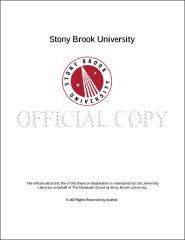| dc.identifier.uri | http://hdl.handle.net/11401/77476 | |
| dc.description.sponsorship | This work is sponsored by the Stony Brook University Graduate School in compliance with the requirements for completion of degree. | en_US |
| dc.format | Monograph | |
| dc.format.medium | Electronic Resource | en_US |
| dc.language.iso | en_US | |
| dc.publisher | The Graduate School, Stony Brook University: Stony Brook, NY. | |
| dc.type | Dissertation | |
| dcterms.abstract | The excessive X-ray radiation exposure during clinical examinations has been reported to be linked to increase lifetime risk of cancers in patients. Directly lower computed tomography (CT) dose without improving reconstruction technique will degrade the image quality and is not acceptable. The objective of this dissertation is investigating novel reconstruction methods to improve image quality in low-dose cases. In practice, it is usually more convenient to improve the conventional analytical methods by refining projection model and designing new filters due to the fast computing time and low computational complexity. However, the reconstructions from analytical methods are still sensitive to artifacts and photon noise; therefore, the improved analytical methods may not be applicable to low-dose CT reconstructions. Recently, iterative image reconstruction methods have been found to be very effective in low-dose CT reconstruction and can be mainly classified into two categories: statistical iterative reconstruction methods and algebraic iterative reconstruction methods. The statistical iterative reconstruction methods, which incorporate statistical noise model, prior model and projection geometry, have shown the ability to reduce noise and improve resolution for image reconstruction from low-mAs projection data. The algebraic iterative reconstruction methods, which were originally invented in 1970s, have been improved in the past decade to reconstruct image from sparse-view projection data, particularly when adequate prior models are used as objective functions. In this dissertation, four improved reconstruction methods are proposed and discussed for different types of low-dose data (for example: low-mAs and sparse-view data). Both computer simulation and real data (i.e., physical phantom and patients' data) are used for evaluations. The clinical potentials of the proposed methods are also exploited in this dissertation. | |
| dcterms.available | 2017-09-20T16:52:46Z | |
| dcterms.contributor | Liang, Jerome Z | en_US |
| dcterms.contributor | Robertazzi, Thomas | en_US |
| dcterms.contributor | Gindi, Gene | en_US |
| dcterms.contributor | Subbarao, Muralidhara | en_US |
| dcterms.contributor | Moore, William. | en_US |
| dcterms.creator | Liu, Yan | |
| dcterms.dateAccepted | 2017-09-20T16:52:46Z | |
| dcterms.dateSubmitted | 2017-09-20T16:52:46Z | |
| dcterms.description | Department of Electrical Engineering. | en_US |
| dcterms.extent | 148 pg. | en_US |
| dcterms.format | Application/PDF | en_US |
| dcterms.format | Monograph | |
| dcterms.identifier | http://hdl.handle.net/11401/77476 | |
| dcterms.issued | 2014-12-01 | |
| dcterms.language | en_US | |
| dcterms.provenance | Made available in DSpace on 2017-09-20T16:52:46Z (GMT). No. of bitstreams: 1
Liu_grad.sunysb_0771E_12102.pdf: 26966876 bytes, checksum: d39f1cdcc7f9e8a987e04bdf0bf70ae5 (MD5)
Previous issue date: 1 | en |
| dcterms.publisher | The Graduate School, Stony Brook University: Stony Brook, NY. | |
| dcterms.subject | analytical reconstruction, Computed Tomography, image reconstruction, iterative reconstruction, total variation stokes, volume shadow weighting | |
| dcterms.subject | Electrical engineering | |
| dcterms.title | Image reconstruction theory and implementation for low-dose X-ray computed tomography | |
| dcterms.type | Dissertation | |

